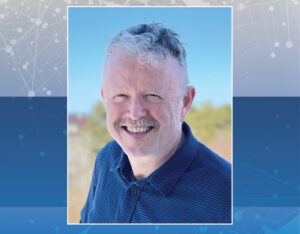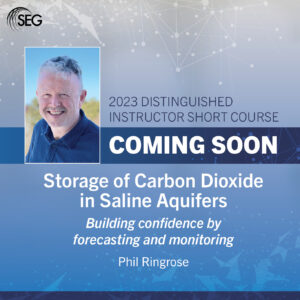9-10 April 2024
Event phone:
Course Description
2023–2024 DISC: Storage of Carbon Dioxide in Saline Aquifers
Building confidence by forecasting and monitoring
Instructor: Phil Ringrose, Equinor & NTNU
Description
Interest in CCS is growing rapidly as part of global efforts to reduce greenhouse gas emissions to atmosphere. To support this growth in capture technology we need to see an acceleration in new CO2 storage project developments. In this course, we review the science and technology underpinning CO2 storage in deep saline aquifer formations using insights from several industrial-scale projects. We look at the main factors which limit storage capacity – constraints governed by flow dynamics, injectivity, pressure development, and geomechanics. This physical basis provides a framework for working out how to optimize monitoring methods. Using the latest portfolio of geophysical methods for smart and cost-effective monitoring at surface and downhole (including conventional seismic acquisition, passive seismic listening, and fiber-optic sensing), we discuss how short- and long-term storage assurance can be demonstrated with high levels of confidence. We then address the question of what it takes to achieve climate-significant scales of CCS deployment. While this is technically achievable, the current socio-economic framing often makes storage project execution difficult in practice. By building technical confidence in project execution, we may be able ‘turn the dial’ and realize the Gigatonne levels of storage needed over the coming decades.
Topics this course will cover
• What are the main processes involved in the geologic storage of CO2
• How should we estimate CO2 storage capacity?
• What is the physical basis for estimates of storage efficiency?
• What about the constraints to storage? When does injectivity matter? Or are pressure limits the main issue?
• What are the geomechanical limits? Should we expect significant levels of induced seismicity?
• How can we optimize monitoring methods to make them smart and cost-effective?
• How good is time-lapse seismic at detecting small CO2 volumes in the subsurface?
• How can fiber-optic sensing (DAS) bring down the costs and footprints of monitoring schemes?
• How can we apply advanced analysis (e.g., FWI) for monitoring using sparse acquisitions?
• How can we assure long-term containment? What about leakage risks?
• And finally, is the required global scale-up in CCS deployment achievable?
Goals
The goal of this course is to review the main concepts involved in the engineered storage of CO2 in saline aquifer formations, dispelling some common misunderstandings along the way. After explaining the main trapping mechanisms, we critically assess methods for estimating storage capacity and evaluate the key constraints to achieving the storage volumes needed over the project timeframe. The course material has a strong focus on geophysical monitoring methods and datasets, which are key to the stated objective of building confidence in the technology and for assuring long-term storage integrity.
Who should attend
All those interested in getting up to speed with the state of play in saline aquifer CO2 storage technology. The main target audience are multi-disciplinary subsurface teams, and the content covers relevant aspects of geoscience, geophysics and reservoir engineering. Managers, team leaders and business developers should also find most of the material accessible. For subsurface specialists the focus is on learning across disciplines, e.g., how might flow analysis affect site selection choices, or how do ‘geological details’ impact on the engineering assessment? With a strong focus on advanced geophysical monitoring (especially time-lapse seismic), geophysicists will find the course helpful for designing and interpreting seismic monitoring datasets. This course does not require advanced mathematical knowledge, although several governing equations are introduced and used. The main objective is to provide an intuitive understanding of the geoscience, physics and geophysics of CO2 storage in saline aquifers. A familiarity with integrated 3D subsurface modeling and seismic interpretation tools will be an advantage but is not essential.
Course Book
Course attendees receive the book as part of the registration fee. If you are unable to attend the DISC course, but interested in the book, it can be purchased in print or as an ebook.
Instructor Biography
 Philip S. Ringrose is a Specialist in reservoir geoscience at Equinor and Adjunct Professor in CO2 Storage at the Norwegian University of Science and Technology. He has been engaged with many CCS project developments over the last 15 years and has published widely on reservoir geoscience and fluid flow in rock media, including the textbooks ‘Reservoir Model Design’ and ‘How to Store CO2 underground.’
Philip S. Ringrose is a Specialist in reservoir geoscience at Equinor and Adjunct Professor in CO2 Storage at the Norwegian University of Science and Technology. He has been engaged with many CCS project developments over the last 15 years and has published widely on reservoir geoscience and fluid flow in rock media, including the textbooks ‘Reservoir Model Design’ and ‘How to Store CO2 underground.’
Ringrose holds a BSc in geology from the University of Edinburgh and a PhD in applied geology from University of Strathclyde in Scotland. He is a member of SEG, EAGE, and the Geological Society (London), and was the 2014-2015 President of the EAGE. In 2018 he was appointed as Honorary Professor at the University of Edinburgh and in 2020 he was elected as a member of The Royal Norwegian Society of Sciences and Letters (DKNVS).
Registration
Registrations are open now! Book your ticket via the SEG website.
SEG/GESGB Member Price – US$375.00
Non-Member Price – US$560.00
Student Price – US$100.00

Venue Information
Venue information
Venue name:
Online
Venue address:
This event will be delivered online.


